Whirlpool WRV996FDEH01, WRV986FDEM01, WRV996FDEM01, WRV996FDEE02, WRV996FDEE01 Owner’s Manual
...



 REFRIGERATOR USER INSTRUCTIONS
REFRIGERATOR USER INSTRUCTIONS
THANK YOU for purchasing this high-quality product. Register your new refrigerator at www.whirlpool.com. In Canada, register your refrigerator at www.whirlpool.ca.
For future reference, please make a note of your product model and serial numbers. These can be located on the inside wall of the refrigerator compartment.
Model Number___________________________________________ Serial Number____________________________________________
Table of Contents |
|
REFRIGERATOR SAFETY.............................................................. |
2 |
Proper Disposal of Your Old Refrigerator..................................... |
3 |
INSTALLATION INSTRUCTIONS................................................... |
3 |
Unpack the Refrigerator............................................................... |
3 |
Remove and Replace Refrigerator Doors.................................... |
4 |
Remove and Replace Drawer Fronts........................................... |
6 |
Align Doors and Drawers.............................................................. |
8 |
Location Requirements............................................................... |
10 |
Electrical Requirements.............................................................. |
11 |
Water Supply Requirements....................................................... |
11 |
Connect the Water Supply......................................................... |
11 |
Handle Installation and Removal................................................ |
13 |
Refrigerator Leveling and Door Closing..................................... |
14 |
FILTERS AND ACCESSORIES..................................................... |
15 |
Water Filtration System.............................................................. |
15 |
Install Air Filter (on some models).............................................. |
16 |
Install Produce Preserver |
|
(on some models)....................................................................... |
17 |
Accessories................................................................................. |
17 |
REFRIGERATOR USE................................................................... |
17 |
Opening and Closing Doors....................................................... |
17 |
Using the Controls...................................................................... |
18 |
Refrigerator Features.................................................................. |
20 |
Water and Ice Dispensers........................................................... |
22 |
Ice Maker and Ice Storage Bin |
|
(on some models)....................................................................... |
25 |
REFRIGERATOR CARE................................................................ |
26 |
Cleaning...................................................................................... |
26 |
Lights.......................................................................................... |
27 |
Vacation and Moving Care......................................................... |
27 |
TROUBLESHOOTING................................................................... |
28 |
PERFORMANCE DATA SHEET.................................................... |
33 |
W10730915C

REFRIGERATOR SAFETY
Your safety and the safety of others are very important.
many important safety messages in this manual and on your appliance. Always read and obey all safety
safety alert symbol.
alerts you to potential hazards that can kill or hurt you and others.
messages will follow the safety alert symbol and either the word “DANGER” or “WARNING.” mean:
 DANGER
DANGER  WARNING
WARNING
You can be killed or seriously injured if you don't immediately follow instructions.
You can be killed or seriously injured if you don't follow instructions.
All safety messages will tell you what the potential hazard is, tell you how to reduce the chance of injury, and tell you what can happen if the instructions are not followed.
IMPORTANT SAFETY INSTRUCTIONS
WARNING: To reduce the risk of fire, electric shock, or injury when using your refrigerator, follow these basic precautions:
■Plug into a grounded (earthed) outlet.
■Do not remove ground prong.
■Do not use an adapter.
■Do not use an extension cord.
■Disconnect power before servicing.
■Replace all parts and panels before operating.
■Remove doors from your old refrigerator.
■Use nonflammable cleaner.
■Do not store or use petrol, flammable liquids or gas in the vicinity of this or other electrical appliances. The fumes can cause fires or explosions.
■Do not store explosive substances such as aerosol cans with a flammable propellant in this refrigerator.
■Do not use or place electrical devices inside the refrigerator compartments if they are not of the type expressly authorized by the manufacture.
■Use two or more people to move and install refrigerator.
■Disconnect power before installing ice maker (on ice maker kit ready models only).
■A qualified service technician must install the water line and ice maker.
■Connect to a potable water supply only.
■Use a sturdy glass when dispensing ice (on some models).
■This appliance is not intended for use by persons (including children) with reduced physical, sensory or mental capabilities, or lack of experience and knowledge, unless they have been given supervision or instruction concerning use of the appliance by a person responsible for their safety.
■Children should be supervised to ensure that they do not play with the appliance.
■To avoid the risk of children becoming trapped and suffocating, do not allow them to play or hide inside the refrigerator.
■If the power supply cord is damaged, it must be replaced by the manufacturer or its service agent or a similarly qualified person.
SAVE THESE INSTRUCTIONS
2
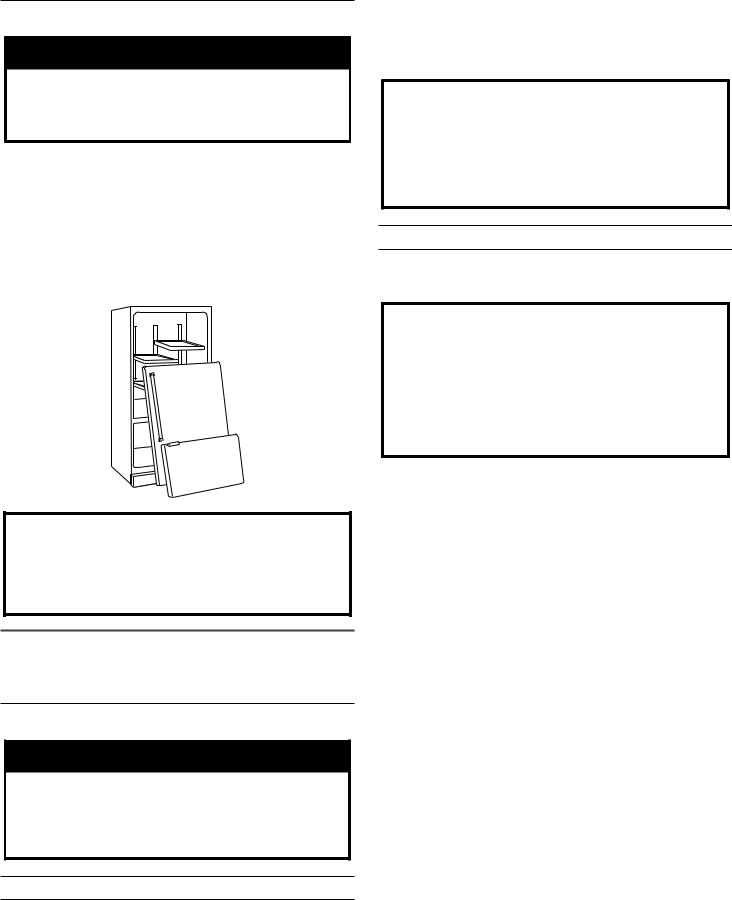
Proper Disposal of Your Old Refrigerator
 WARNING
WARNING
Suffocation Hazard Remove doors from your old refrigerator.
Failure to do so can result in death or brain damage.
IMPORTANT: Child entrapment and suffocation are not problems of the past. Junked or abandoned refrigerators are still dangerous –even if they will sit for “just a few days.” If you are getting rid
of your old refrigerator, please follow these instructions to help prevent accidents.
Before You Throw Away Your Old Refrigerator or Freezer:
■■ Take off the doors.
■■ Leave the shelves in place so that children may not easily climb inside.
Important information to know about disposal of refrigerants:
Dispose of refrigerator in accordance with Federal and Local regulations. Refrigerants must be evacuated by a licensed, EPA certified refrigerant technician in accordance with established procedures.
INSTALLATION
INSTRUCTIONS
Unpack the Refrigerator
 WARNING
WARNING
Excessive Weight Hazard
Use two or more people to move and install refrigerator.
Failure to do so can result in back or other injury.
Remove the Packaging
■■ Remove tape and glue residue from surfaces before turning on the refrigerator. Rub a small amount of liquid dish soap over the adhesive with your fingers. Wipe with warm water and dry.
■■ Do not use sharp instruments, rubbing alcohol, flammable fluids, or abrasive cleaners to remove tape or glue. These products can damage the surface of your refrigerator. For more information, see “Refrigerator Safety.”
■■ Dispose of/recycle all packaging materials.
When Moving Your Refrigerator:
Your refrigerator is heavy. When moving the refrigerator for cleaning or service, be sure to cover the oor with cardboard or hardboard to avoid oor damage. Always pull the refrigerator straight out when moving it. Do not wiggle or “walk” the refrigerator when trying to move it, as oor damage could occur.
Clean Before Using
After you remove all of the packaging materials, clean the inside of your refrigerator before using it. See the cleaning instructions in “Refrigerator Care.”
Important information to know about glass shelves and covers:
Do not clean glass shelves or covers with warm water when they are cold. Shelves and covers may break if exposed to sudden temperature changes or impact, such as bumping. Tempered glass is designed to shatter into many small, pebble-size pieces. This is normal. Glass shelves and covers are heavy. Use both hands when removing them to avoid dropping.
3
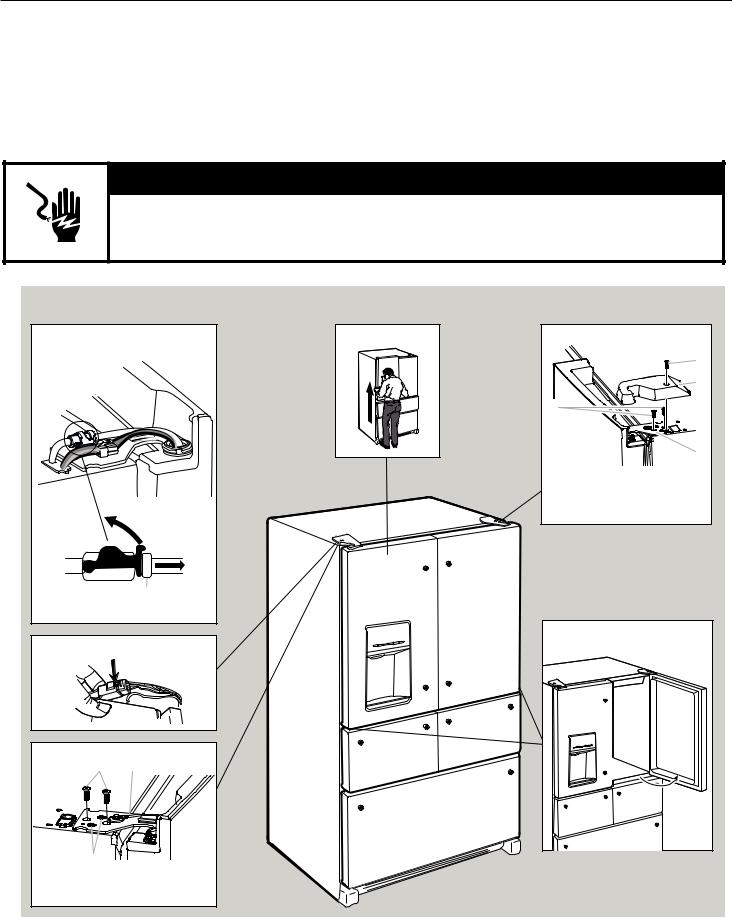
Remove and Replace Refrigerator Doors
NOTE: Measure the width of your door opening to see whether or not you need to remove the refrigerator doors to move the refrigerator into your home. If door removal is necessary, see the following instructions.
IMPORTANT: If the refrigerator was previously installed and you are moving it out of the home, before you begin, turn the refrigerator control OFF. Unplug the refrigerator or disconnect power. Remove food and adjustable door or utility bins from doors.
Gather the required tools and read all instructions before removing doors. TOOLS NEEDED: 3/16" hex key and a #2 Phillips screwdriver
 WARNING
WARNING
Electrical Shock Hazard
Disconnect power before removing doors.
Failure to do so can result in death or electrical shock.
|
|
Door Removal and Replacement |
|
Water Dispenser |
Door Removal |
Top Right Hinge |
|
Tubing Connection |
|
B |
|
|
|
|
|
|
|
|
C |
|
|
|
A |
|
|
|
D |
|
|
|
A. 3/16" Internal Hex-Head Screws |
|
|
|
B. Hinge Cover Screw |
|
|
|
C. Top Hinge Cover |
|
|
|
D. Top Hinge |
|
A |
|
|
A. Outer Ring |
|
|
|
|
|
|
Door at 90° Angle |
Wiring Plug |
|
to Cabinet |
|
Top Left Hinge |
|
|
|
A |
B |
|
|
|
|
|
90° |
C |
|
|
|
A. 3/16" Internal Hex-Head Screws |
|
|
|
B. Ground Wire (Do Not Remove.) |
|
|
|
C. Do Not Remove Screws |
|
|
|
4

Remove Refrigerator Doors
 WARNING
WARNING
Electrical Shock Hazard Disconnect power before removing doors.
Failure to do so can result in death or electrical shock.
Remove Right-Hand Refrigerator Door
1.Unplug refrigerator or disconnect power.
2.Keep the refrigerator doors closed until you are ready to lift them free from the cabinet.
NOTE: Provide additional support for the refrigerator door while the hinges are being removed. Do not depend on the door gasket magnets to hold the door in place while you are working.
3.Using a Phillips screwdriver, remove the cover from the top hinge.
4.Using the 3/16" hex key wrench, remove the two internal hexhead screws from the top hinge, and set aside.
NOTE: Do not remove the two locator screws. These screws will help you align the hinge when you replace the door.
|
A |
|
B |
C |
|
|
D |
A. Top hinge cover screw |
C. 3/16" Internal hex-head screws |
B. Top hinge cover |
D. Top hinge |
 WARNING
WARNING
Excessive Weight Hazard
Use two or more people to lift the refrigerator door. Failure to do so can result in back or other injury.
5.Lift the refrigerator door from the bottom hinge pin. The top hinge will come away with the door.
Remove Left-Hand Refrigerator Door
IMPORTANT: The tubing and wiring for the water dispenser run through the left-hand door hinge, so they must be disconnected before removing the door.
1.Using a Phillips screwdriver, remove the cover from the top hinge.
A 

B 
A. Top hinge cover screw B. Top hinge cover
2.Disconnect the water dispenser tubing located on top of the door hinge. Firmly pulling up on the clasp, and then pull the tubing out of the fitting.
NOTE: The water dispenser tubing remains attached to the left-hand refrigerator door.
3.Disconnect the wiring plug located on top of the door hinge.
■■ Grasp each side of the wiring plug. With your left thumb, press down to release the catch and pull the sections of the plug apart.
NOTE: Do not remove the green, ground wire. It should remain attached to the door hinge.
4.Using the 3/16" hex key wrench, remove the two internal hexhead screws from the top hinge and set aside.
NOTES:
■■ Provide additional support for the refrigerator door while the hinges are being removed. Do not depend on the door gasket magnets to hold the door in place while you are working.
5
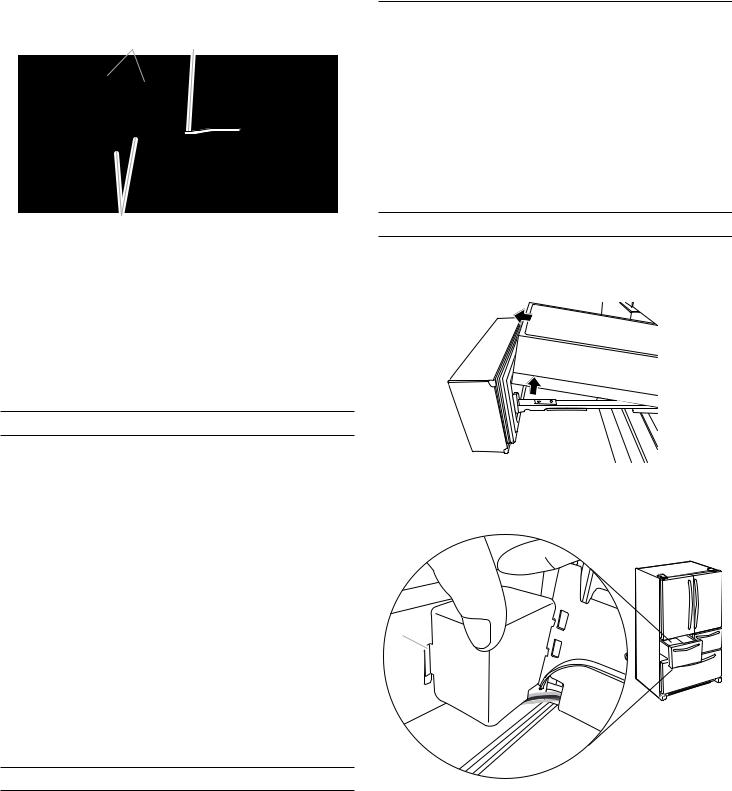
■■ Do not remove the two locator screws. These screws will help you align the hinge when you replace the door.
A B
C
A. 3/16" Internal hex-head |
C. Locator screws |
screws |
(Do not remove) |
B.Ground wire (Do not remove)
5.Lift the refrigerator door from the bottom hinge pin. The top hinge will come away with the door.
NOTE: It may not be necessary to remove the bottom hinges and brake feet assemblies to move the refrigerator through a doorway.
■■ Only if necessary, use a driver with a #2 square bit tip to
remove the bottom hinges and a 3/8" nut driver to remove the brake feet screws.
Replace Refrigerator Doors
Replace Right-Hand Refrigerator Door
1.Set the right-hand door onto the bottom hinge pin.
2.Insert the top hinge pin into the open hole in the top of the refrigerator door.
3.Using the two 3/16" internal hex-head screws, fasten the hinge to the cabinet. Do not tighten the screws completely.
Replace Left-Hand Refrigerator Door
IMPORTANT: Do not intertwine the water tubing and wiring bundles when reconnecting them.
1.Set the left-hand door onto the bottom hinge pin.
2.Using the two 3/16" internal hex-head screws, fasten the hinge to the cabinet. Do not tighten the screws completely.
3.Reconnect the water dispenser tubing.
Style 1 - Insert the tubing into the fitting until it stops and the outer ring is touching the face of fitting.
Style 2 - Insert the tubing firmly into the fitting until it stops. Close the clasp around the tubing. The clasp snaps into place between the fitting and the collar.
4.Reconnect the electrical wiring.
■■ Push together the two sections of the wiring plug.
Final Steps
1.Completely tighten the four internal hex-head screws (two on the right-hand door hinge and two on the left-hand door hinge).
2.Replace both top hinge covers.
Remove and Replace Drawer Fronts
Depending on the width of your door opening, it may be necessary to remove the drawer fronts to move the refrigerator into your home.
IMPORTANT:
■■ If the refrigerator was previously installed and you are moving it out of the home, before you begin, turn the refrigerator control off, and unplug the refrigerator or disconnect power. Remove food from the drawers.
■■ Two people may be required to remove and replace the drawer fronts.
Tools Needed: Flat-blade screwdriver
Refrigerated Drawers
Remove the Drawer Fronts
1.Open the drawer to its full extension. Grasp the sides of the interior bin, and then lift up and out to remove.
2.Left-hand drawer only: Remove the wiring connection cover. Press in on the side of the cover to release the tab from the slot, and then pull the cover away from the bracket.
A
B 
A.Cover tab
B.Wiring connection cover
3.Left-hand drawer only: Disconnect the wiring.
NOTE: The drawer front of the left-hand refrigerated drawer is connected to the temperature control by wires running underneath the drawer glide. Before removing the drawer front, the wires must be disconnected.
6
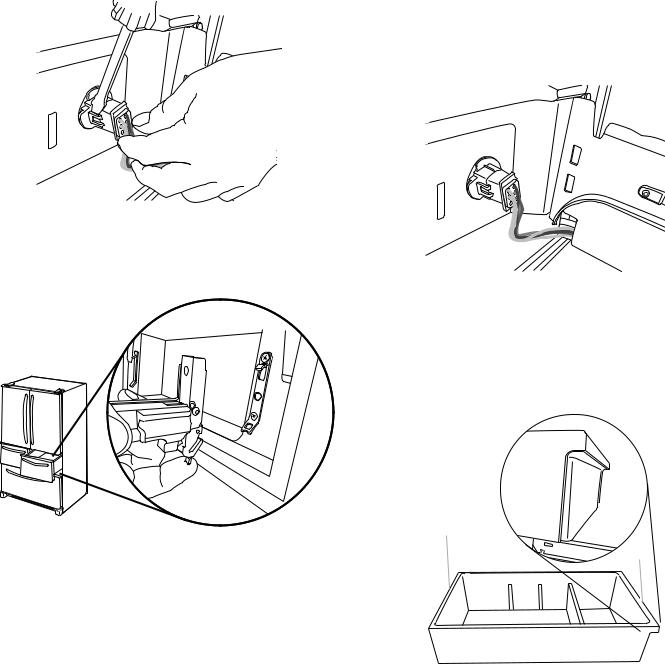
■■ On one side of the wiring connector, insert the screwdriver |
3. Left-hand drawer only: Reconnect wiring. |
|
blade between the connector tab and the connector to |
■■ Align the two ends of the wiring connector and push them |
|
release. Repeat for the opposite side. Pull the wiring |
||
together until you hear a “click” sound and feel the tabs |
||
connector apart. |
||
snap into place on the connector. |
||
|
||
|
■■ Gently pull on the wiring connection to ensure the wiring |
|
|
connection is completely seated. Replace the wiring |
|
|
cover. |
|
|
NOTE: The wiring connection must be complete for the |
|
|
drawer temperature control to operate. |
4.Remove the drawer front.
■■ Push up on the lever at the bottom of the drawer glide bracket to release the drawer front from the bracket.
■■ Lift the drawer front up and off the drawer glide brackets.
 A
A
 B
B
A. Drawer glide bracket |
B. Release lever |
5. Slide the drawer glides back into the refrigerator.
Replace the Drawer Fronts
1.Pull out the drawer glides until they are fully extended.
2.Push up on the lever at the bottom of the drawer glide bracket to open. Insert the drawer front bracket into the drawer glide bracket and release the lever.
NOTE: It helps if one person holds the drawer glides steady while another person aligns the drawer front and connects the brackets.
4.Left-hand drawer only: Replace the wiring connection cover.
5.Replace the drawer bins onto the drawer glides with the rear side of the bin facing the back of the refrigerator, as shown.
IMPORTANT: The Door Ajar alarm will sound if the interior drawer bins are not replaced correctly. The bins are designed with a specific front and rear. They must be placed into the drawers, as shown, so that the refrigerated drawers will close and operate properly.
B
A
A.Faces back of refrigerator (insert first)
B.Faces front of refrigerator
7
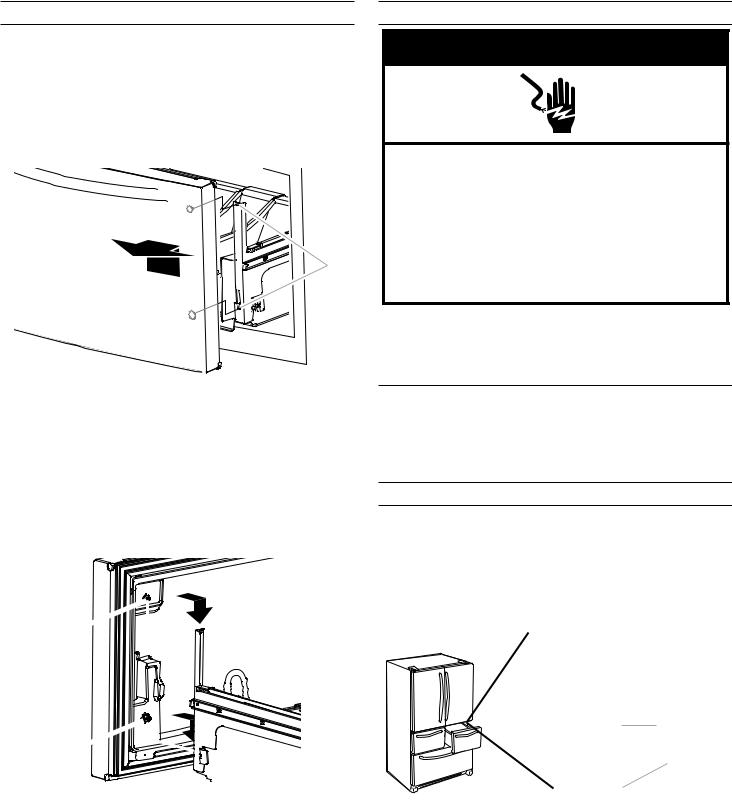
Freezer Drawer
Remove Drawer Front
1.Open the freezer drawer to its full extension.
2.Loosen the two top screws that fasten the drawer front to the drawer glides. The two screws (one on the left-hand side and one on the right-hand side) are located inside the drawer front.
3.Lift up on the drawer front to release the plastic studs from the drawer glide bracket slots.
`
A
A.Drawer glide bracket slots
4.Slide the drawer glides back into the freezer.
Replace Drawer Front
1.Pull out the freezer drawer glides to their full extension.
2.Holding the drawer front by its sides, align the two plastic studs, located at the bottom, inside the drawer front, with the drawer glide bracket slots.
NOTE: It helps if one person holds the drawer glides steady while another person aligns the drawer front and inserts the studs into the slots.
A 
B 

A.Drawer front screw
B.Drawer front plastic stud
3.Replace and tighten the two screws at the top of the drawer front (one on the left-hand side and one on the right-hand side).
Final Steps
 WARNING
WARNING
Electrical Shock Hazard Plug into a grounded 3 prong outlet. Do not remove ground prong.
Do not use an adapter.
Do not use an extension cord.
Failure to follow these instructions can result in death, fire, or electrical shock.
1.Plug into a grounded 3 prong outlet.
2.Reset the controls. See “Using the Control(s)” and “Temperature Controlled Exterior Drawer.”
3.Return all removable parts and the food to the drawers.
Align Doors and Drawers
Once the doors and drawer fronts are replaced on the refrigerator, you may notice that the doors appear angled or that they are no longer level. Both the refrigerator doors and refrigerated drawers are adjustable.
Align Refrigerator Door
Tools Provided: 1/8" hex key
1.Keeping both refrigerator doors closed, pull out the right-hand refrigerated drawer. Locate the bottom hinge pin of the refrigerator door. The alignment screw is inside the bottom hinge pin.
A.Bottom hinge pin
B.Turn to the right to raise.
A 

B
C 
D
C.Turn to the left to lower.
D.1/8" Hex key
2.Insert the short end of the 1/8" hex key (packed with the Door Handle Installation Instructions) into the bottom hinge pin until it is fully engaged in the alignment screw.
■■ To raise the door, turn the hex key to the right. ■■ To lower the door, turn the hex key to the left.
3.Continue to turn the alignment screw until the doors are
aligned.
8
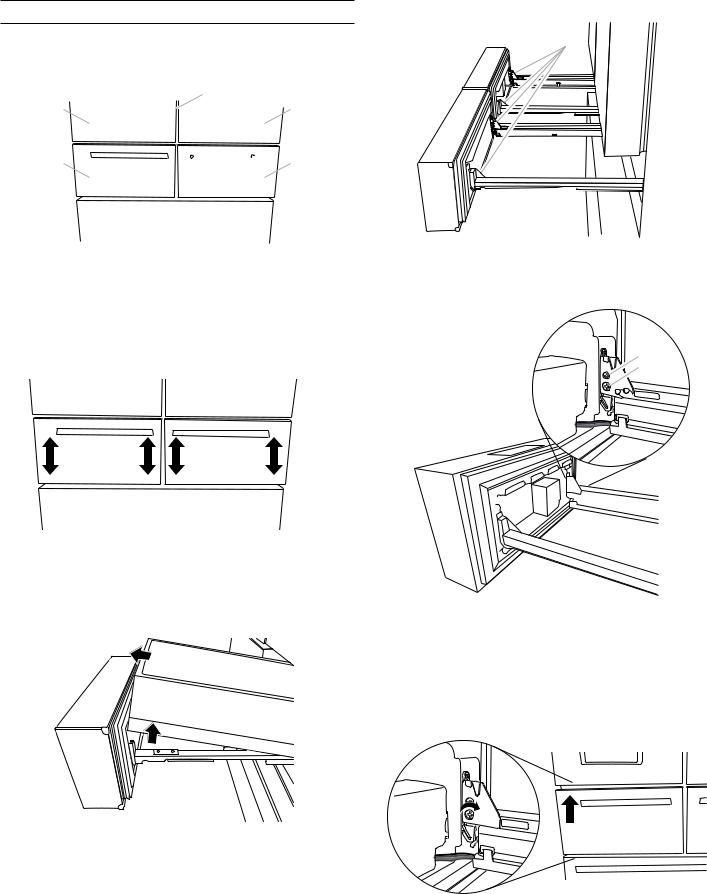
Align Refrigerated Drawer Fronts
When the drawer fronts are aligned, the width of the vertical space (A) between the refrigerator doors (B) and the drawer fronts
(C) is the same thickness, and the drawers appear level.
A
B
 B
B
C

 C
C
Aligning the drawer fronts is a two-step process. The first step is to adjust the drawer fronts up and down. The second step shifts the drawer fronts from side to side. Visually inspect the
refrigerator for alignment and adjust the drawer fronts as needed.
Step 1 - Adjust the Drawer Fronts Up/Down
IMPORTANT: Each refrigerated drawer can be adjusted up and down on both the left and the right sides.
Tools Needed: Phillips screwdriver
1.With the drawers closed, identify the drawer front that needs to be raised or lowered.
2.Open the drawer to its full extension. Grasp the sides of the interior bin, and then lift it up and out to remove.
3. Locate the drawer glide brackets (A).
A
A.Drawer glide brackets
4.Insert the Phillips screwdriver into screw (A) and turn counterclockwise to loosen the drawer front.
A
B
A.Tightening screw
B.Adjusting screw
5.Insert the Phillips screwdriver into screw (B) to adjust the drawer front.
IMPORTANT: The direction you turn screw (B) depends on which side of the drawer you are adjusting.
Left-Hand Side Drawer Glide
■■ To raise the drawer front, turn screw (B) clockwise.
■■ To lower the drawer front, turn screw (B) counterclockwise.
9

Right-Hand Side Drawer Glide
■■ To raise the drawer front, turn screw (B) counterclockwise. ■■ To lower the drawer front, turn screw (B) clockwise.
6.Insert the Phillips screwdriver into screw (A), and turn clockwise to tighten the drawer front.
7.Close the refrigerated drawer to check the alignment. Repeat steps 2 through 6 until the drawer fronts are level.
Step 2 - Adjust the Drawer Fronts Side to Side
IMPORTANT: Each refrigerated drawer can be adjusted side to side on both the left and right side.
1.With the drawers closed, identify the drawer that is not aligned.
2.Open the drawer to its full extension. Grasp the sides of the interior bin, and then lift it up and out to remove. (See Step 1 for further details.)
3.Locate the drawer glide brackets. (See Step 1 for further details.)
4.Starting with the glide bracket closest to the vertical gap, press and hold the release lever (C) up. With your other hand, lift the door clip (A) from the bracket (B).
A
A
B
 B
B
C
A.Drawer front clip
B.Drawer glide bracket
C.Release lever
5.Reposition the clip (A) onto the glide bracket (B) in the direction you want to move the drawer front. Make sure that the glide bracket is vertically level.
6.Release the lever (C) to lock the glide bracket into position.
7.Repeat steps 3 through 6 for the other side of the drawer front.
NOTE: Adjust the clip (A) on the top of the second glide bracket (B) so that it is in the same position as the side you adjusted first.
8.Close the drawer and visually inspect the gap. Repeat steps 2 though 7 until the drawer fronts are aligned.
Final Steps
1.Replace the interior drawer bins.
NOTE: The bins must be placed into the drawers correctly so that the refrigerated drawers will close and operate properly. See “Remove and Replace Drawer Fronts.”
2.Close the refrigerated drawers.
Location Requirements
 WARNING
WARNING
Explosion Hazard
Keep ammable materials and vapors, such as gasoline, away from refrigerator.
Failure to do so can result in death, explosion, or re.
IMPORTANT: This appliance is intended to be used in household and similar applications such as.
■■ Staff kitchen areas in shops, offices and other working environments.
■■ Farm houses and by clients in hotels, motels and other residential type environments.
■■ Bed and breakfast type environments.
■■ Catering and similar non-retail applications.
NOTE: If the manufacturer wants to limit the use of the appliance to less than the above, this has to be clearly stated in the instructions.
To ensure proper ventilation for your refrigerator, allow for a 1/2" (1.25 cm) of space on each side and at the top. Allow for a 1" (2.54 cm) space behind the refrigerator. If your refrigerator
has an ice maker, allow extra space at the back for the water line connections. When installing your refrigerator next to a fixed wall, leave a 3³⁄4" (9.5 cm) minimum space between the refrigerator and wall to allow the door to swing open.
10
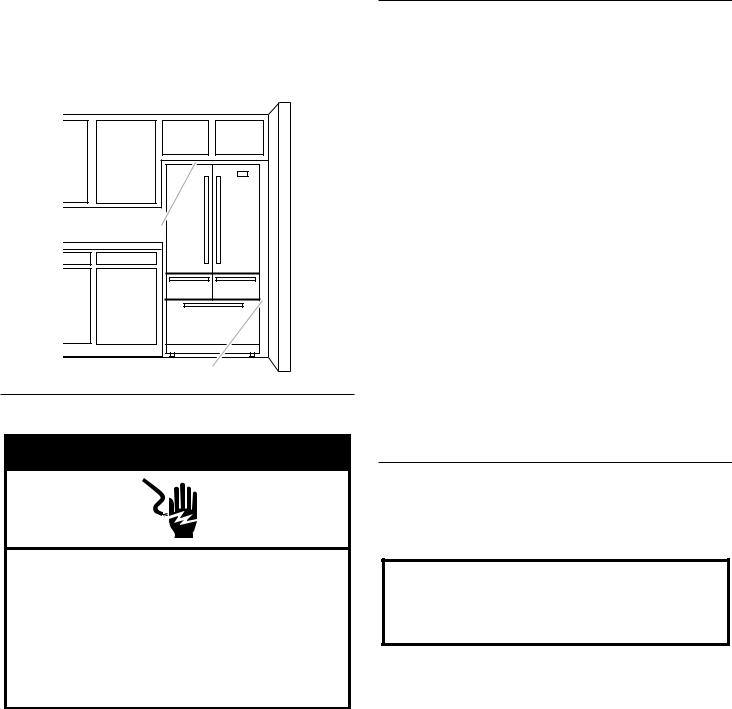
NOTE: This refrigerator is intended for use in a location where the temperature ranges from a minimum of 55°F (13°C) to a maximum of 110°F (43°C). The preferred room temperature range for optimum performance, which reduces electricity usage and provides superior cooling, is between 60°F (15°C) and 90°F (32°C). It is recommended that you do not install the refrigerator near a heat source, such as an oven or radiator.
1/2" (1.25 cm)
33/4" (9.5 cm)
Electrical Requirements
 WARNING
WARNING
Electrical Shock Hazard Plug into a grounded 3 prong outlet. Do not remove ground prong.
Do not use an adapter.
Do not use an extension cord.
Failure to follow these instructions can result in death, fire, or electrical shock.
Before you move your refrigerator into its final location, it is important to make sure you have the proper electrical connection.
If the supply cord is damaged, it must be replaced by the manufacturer or its service agent or a similarly qualified person. Do not use a cord that shows cracks or abrasion damage along its length or at either the plug or connector end.
Recommended Grounding Method
A 115 V, 60 Hz, AC only 15 or 20 A fused, grounded electrical supply is required. It is recommended that a separate circuit serving only your refrigerator and approved accessories be provided. Use an outlet that cannot be turned off by a switch. Do not use an extension cord.
NOTE: Before performing any type of installation, cleaning, or removing a light bulb, turn off Cooling, and then disconnect the refrigerator from the electrical source. When you have finished, reconnect the refrigerator to the electrical source and turn on Cooling. See “Using the Control(s).”
Water Supply Requirements
A cold water supply with water pressure between 35 and 120 psi (241 and 827 kPa) is required to operate the water dispenser and ice maker. If you have questions about your water pressure, call a licensed, qualified plumber.
NOTE: If the water pressure is less than what is required, the flow of water from the water dispenser could decrease or ice cubes could be hollow or irregular shaped.
Reverse Osmosis Water Supply
IMPORTANT: The pressure of the water supply coming out of a reverse osmosis system going to the water inlet valve of the refrigerator needs to be between 35 and 120 psi
(241 and 827 kPa).
If a reverse osmosis water filtration system is connected to your cold water supply, the water pressure to the reverse osmosis system needs to be a minimum of 40 to 60 psi (276 to 414 kPa).
■■ Check to see whether the sediment filter in the reverse osmosis system is blocked. Replace the filter if necessary.
■■ Allow the storage tank on the reverse osmosis system to refill after heavy use. The tank capacity could be too small to keep up with the requirements of the refrigerator.
NOTE: Faucet-mounted reverse osmosis systems are not recommended.
■■ If your refrigerator has a water filter, it may further reduce the water pressure when used in conjunction with a reverse
osmosis system. Remove the water filter. See “Water Filtration System.”
If you have questions about your water pressure, call a licensed, qualified plumber.
Connect the Water Supply
Read all directions before you begin.
IMPORTANT:
■■ Connect to potable water supply only.
Do not use with water that is microbiologically unsafe or of unknown quality without adequate disinfection before or after the system. Systems certified for cyst reduction may be used on disinfected waters that may contain filterable cysts.
■■ Plumbing shall be installed in accordance with the International Plumbing Code and any local codes and ordinances.
■■ The gray water tubing on the back of the refrigerator (which is used to connect to the household water line) is a PEX (cross-linked polyethylene) tube. Copper and PEX tubing connections from the household water line to the refrigerator are acceptable and will help avoid “off-taste” or odor in your ice or water. Check for leaks.
If PEX tubing is used instead of copper, we recommend the following part numbers:
W10505928RP (7 ft [2.14 m] jacketed PEX), 8212547RP (5 ft [1.52 m] PEX), or W10267701RP (25 ft [7.62 m] PEX).
■■ Install tubing only in areas where temperatures will remain above freezing.
11
